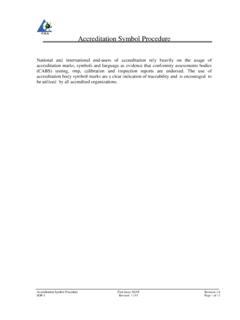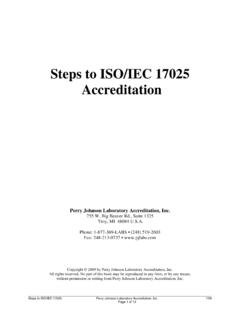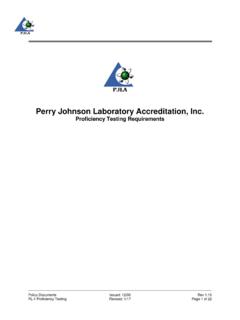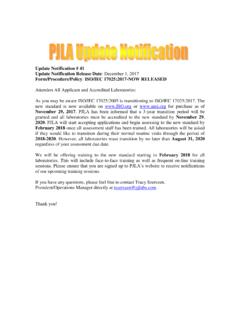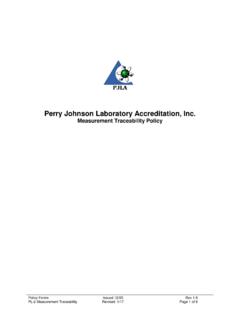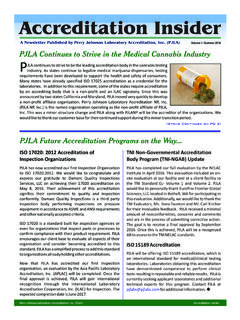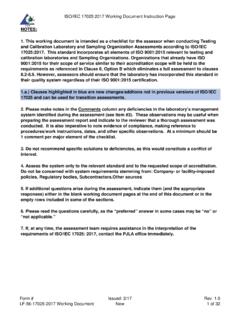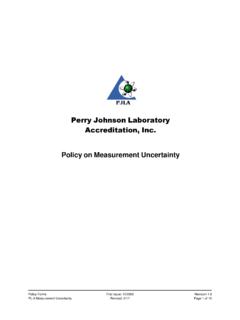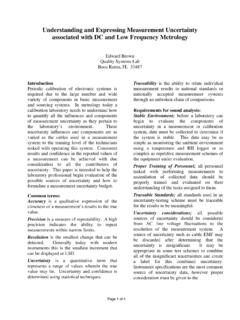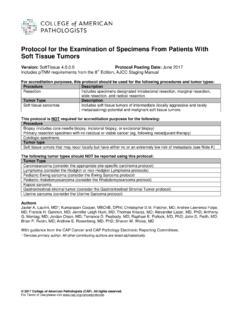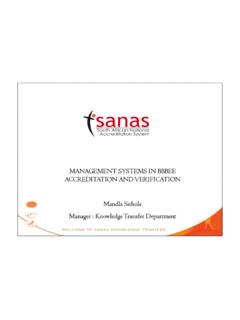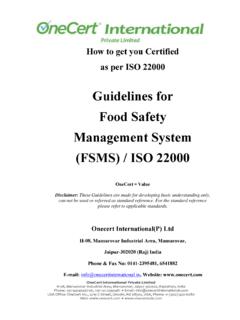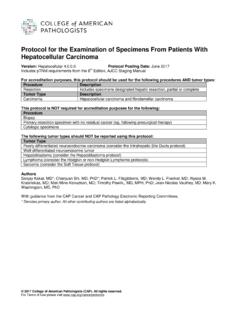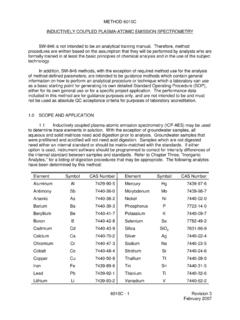Transcription of Work Instruction for Testing Scopes of …
1 Form# Issue Date: 01/07 Rev. WI-8 Revised: 4/2015 Page 1 of 9 Work Instruction for Testing Scopes of accreditation including flexible Scopes The scope of accreditation is a formal document issued by PJLA to its accredited laboratories. It contains information for which accreditation has been granted in regards to the types of tests performed, techniques used and detection limits. It is the responsibility of the laboratory to prepare its proposed scope of accreditation before the initial assessment. The proposed scope of accreditation will be reviewed by the PJLA assessor onsite for accuracy and completeness. Once the assessor has agreed with the proposed scope of accreditation , both the laboratory and the assessor will sign the proposed scope and submit it to PJLA for review with the assessment package.
2 Please note that the submitted scope of accreditation can be modified by PJLA after technical review of the assessment package. Once the accreditation is granted, PJLA will issue a final certificate. The final certificate will be made available to the public through the PJLA website. The following information should be used to complete the scope of accreditation LF-1 Application or LF-64. Form# Issue Date: 01/07 Rev. WI-8 Revised: 4/2015 Page 2 of 9 APPENDIX A Certificate Required Fields/Format Field of Test: The entry in this field needs to represent the generic classification of the Testing services provided by the laboratory.
3 When completing this field, the entry needs to broadly describe the discipline that is to follow in the adjacent columns. Appendix A of this work Instruction includes a listing of appropriate fields to be used based on the types of Testing that is being provided by the laboratory. Should you find that your Testing areas do not fit into the fields listed below, please notify PJLA staff to assist you with completing this section of your scope of accreditation . Testing Field: 1. Biological: Biological, microbiological and biochemical Testing and measurement. 2. Chemical: Chemical analysis and detection including instrumental and automated methods. 3.
4 Dimensional Inspection 4. Electrical: Tests of an electrical and electronic nature performed on instruments, equipment, appliances, components and materials. 5. Environmental: Tests for constituents in various environmental media. 6. Mechanical: Tests, measurements and evaluation of physical properties of materials, components and assemblies. 7. Non-Destructive: Examination of materials, components and assemblies to detect discontinuities without damaging the material, component or assembly. Items, Materials or Products Tested: Define the products, materials or other items that you test using the technology defined in column three. For example: Metals, Waste Water or Plastic Components.
5 Specific Tests or Properties Measured: The entry in this field needs to represent the tests you are performing. This entry needs to be specific and fully describe the test or property so as to indicate the capabilities of the laboratory. Specification, Standard Method or Technique Used: Enter all of the test methods that are used when performing tests in the technologies related to the third column. The test method may be an internationally recognized test method such as ASTM, SAE or other accepted methods. This may also be a customer Form# Issue Date: 01/07 Rev. WI-8 Revised: 4/2015 Page 3 of 9 specified method or internal method. Whichever method is stated on the scope, the laboratory is expected to have available the most current version of that method.
6 Range (Where Appropriate) and Detection Limit: Provide the lower and upper boundaries for the range of the parameter. Beware of including a zero as the lower boundary, especially when a percent or multiplier is used Detection limit for the product in the manner to be tested must be provided. Detection Limit can be expressed in quantitative or qualitative terms as necessary. The capabilities of the laboratory need to be clearly expressed in an easy to understand format. The units, which define the measurement, must comply with acceptable units. Please refer to NIST SP 811 and Appendix B of this document regarding the use of SI units. Format: A separate line entry is needed for each parameter/discipline and/or each range listed for that parameter.
7 For each line entry, a separate line must be used for each range. The format of the example table must be followed. This includes font (Times New Roman), font size (10), column order and column headings, and placement of notes. Blank Boxes and boxes containing the phrase N/A will only be accepted for the range of the parameter and not the detection limit, where applicable. FIELD OF TEST ITEMS, MATERIALS OR PRODUCTS TESTED SPECIFIC TESTS OR PROPERTIES MEASURED SPECIFICATION, STANDARD METHOD OR TECHNIQUE USED RANGE (WHERE APPROPRIATE) AND DETECTION LIMIT Environmental Waste Water Sodium Content EPA 10528 mg/dl to mg/dl mg/dl Mechanical Automotive Components Chipping Resistance SAE 4500A 5% Form# Issue Date: 01/07 Rev.
8 WI-8 Revised: 4/2015 Page 4 of 9 APPENDIX B Guidelines for the use of SI units for the scope of accreditation The General Conference on Weights and Measures established the International System of Units (SI). It is the modern metric system of measurement used throughout the world. PJLA policy requires the use of SI units to be used for reporting results of measurements on Scopes of accreditation . This policy calls for the use of NIST SP 811 for direct guidance on the use of symbols, numbers and the use of the SI Units. It is the responsibility of the client to be aware of the appropriateness of the SI unit on their scope of accreditation as applicable.
9 In some cases, customary units may be more appropriate. The NIST SP 811 can be retrieved from . The following pages contain a small sampling of guidelines and examples contained in the NIST SP 811. Rule: Example: Instead Of: Only units of the SI and those recognized by the SI are used. 10 m 100 C 10 ft 100 F Abbreviations are avoided S or second cm3 or cubic centimeter sec cc ppm, ppb and ppt are avoided 2 ng/kg nm/m 2 ppt ppb Unit symbols are not modified in order to provide information about the quantity. Vmax = 1000 V V = 1000 Vmax The symbol % can be used in place of the number x = = % x = percent Quantities are to be defined so that they can be expressed solely in acceptable units The Ca content is 25 ng/L 25 ng Ca/L Unit and mathematical symbols and names are not mixed m/s or meter per second meter/s Values for quantities are expressed in acceptable units using Arabic numerals and the SI symbols for units The weight of the box was 35 kg.
10 The length of the box was thirty-five kilograms. There is always a space between the quantity and the unit symbol, except 189 kg 25 C 357 189kg 25 C 357 Form# Issue Date: 01/07 Rev. WI-8 Revised: 4/2015 Page 5 of 9 when it is a plane angle 24 (plane angle) 24 (plane angle) A thin space is used to separate digits with more than four per side of a decimal point 123 586 1 or 123,586, Quantity equations are preferred to numerical value equations l = vt {l}m = {v}km/h {t}s A quotient quantity is expressed using divided by instead of per unit Pressure is force divided by area. Pressure is force per unit area. Rule: Example: Instead Of: The terms Normality and Molarity, symbols N and M respectively are obsolete.
